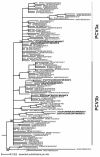Retrospective Detection and Genetic Characterization of Porcine circovirus 3 (PCV3) Strains Identified between 2006 and 2007 in Brazil
- PMID: 30818809
- PMCID: PMC6466443
- DOI: 10.3390/v11030201
Retrospective Detection and Genetic Characterization of Porcine circovirus 3 (PCV3) Strains Identified between 2006 and 2007 in Brazil
Abstract
Porcine circovirus 3 (PCV3) is an emerging virus that was first identified in the United States in 2016. Since its first detection, PCV3 has already been found in America, Asia, and Europe. Although PCV3 has already been described in Brazil, knowledge of its detection and sequence variation before 2016 is limited, as well as its distribution in the main swine producing regions of Brazil. In this study, 67 porcine clinical samples collected from nine states in Brazil between 2006 and 2007 were analyzed for PCV3 infection by PCR. Results showed that 47.8% of the samples were PCV3 positive, across all nine states. Of the PCV3-positive samples, 37.5% were also positive for PCV2. Interestingly, no clinical signs were associated with samples that were detected singularly with PCV3 infection. Moreover, the positive PCV3 rate in healthy pigs was higher (29.8%) than that found in unhealthy pigs (17.9%), suggesting that most pigs could live with PCV3 infection without any clinical sign in the analyzed samples. Nucleotide sequence analysis showed that PCV3 strains obtained in this study shared 94.44% to 99.83% sequence identity at the open reading frame 2 (ORF2) gene level with available strains from different countries. PCV3 Brazilian sequences collected in 2006 and 2007 shared 97.94% to 99.62% identity with the strains obtained in 2016. The results of neutrality and selective pressure tests indicated that the PCV3 Cap protein seems unable to tolerate high levels of variation on its sequence. Phylogenetic analysis grouped the Brazilian strains in PCV3a and PCV3b genotypes clusters, both including strains collected in America, Asia, and Europe. Taking the results together, multiple events of introduction of PCV3 may have occurred in Brazil, and Brazilian PCV3 strains may show genetic stability over the past 10 years.
Keywords: Brazil; PCV3; epidemiology; evolution; phylogeny; retrospective detection.
Conflict of interest statement
The authors declare that they have no conflict of interest.
Figures


Similar articles
-
The prevalence and genetic diversity of porcine circovirus types 2 and 3 in Northeast China from 2015 to 2018.Arch Virol. 2019 Oct;164(10):2435-2449. doi: 10.1007/s00705-019-04336-4. Epub 2019 Jul 4. Arch Virol. 2019. PMID: 31273470
-
Molecular detection and phylogenetic analysis of porcine circovirus type 3 in 21 Provinces of China during 2015-2017.Transbound Emerg Dis. 2019 Mar;66(2):1004-1015. doi: 10.1111/tbed.13125. Epub 2019 Feb 7. Transbound Emerg Dis. 2019. PMID: 30637986
-
Full genome characterization of porcine circovirus type 3 isolates reveals the existence of two distinct groups of virus strains.Virol J. 2018 Jan 29;15(1):25. doi: 10.1186/s12985-018-0929-3. Virol J. 2018. PMID: 29378597 Free PMC article.
-
Novel Porcine Circoviruses in View of Lessons Learned from Porcine Circovirus Type 2-Epidemiology and Threat to Pigs and Other Species.Viruses. 2022 Jan 27;14(2):261. doi: 10.3390/v14020261. Viruses. 2022. PMID: 35215854 Free PMC article. Review.
-
Porcine circovirus 3 in North and South America: Epidemiology and genetic diversity.Transbound Emerg Dis. 2021 Nov;68(6):2949-2956. doi: 10.1111/tbed.14238. Epub 2021 Jul 26. Transbound Emerg Dis. 2021. PMID: 34310859 Review.
Cited by
-
Recent Progress on Epidemiology and Pathobiology of Porcine Circovirus 3.Viruses. 2021 Sep 28;13(10):1944. doi: 10.3390/v13101944. Viruses. 2021. PMID: 34696373 Free PMC article. Review.
-
Prevalence and Evolution Analysis of Porcine Circovirus 3 in China from 2018 to 2022.Animals (Basel). 2022 Jun 20;12(12):1588. doi: 10.3390/ani12121588. Animals (Basel). 2022. PMID: 35739924 Free PMC article.
-
Retrospective study of porcine circovirus 3 (PCV3) in swine tissue from Brazil (1967-2018).Braz J Microbiol. 2020 Sep;51(3):1391-1397. doi: 10.1007/s42770-020-00281-6. Epub 2020 Apr 28. Braz J Microbiol. 2020. PMID: 32347531 Free PMC article.
-
Prevalence of Infection with Porcine Circovirus Types 2 and 3 in the Wild Boar Population in the Campania Region (Southern Italy).Animals (Basel). 2021 Nov 10;11(11):3215. doi: 10.3390/ani11113215. Animals (Basel). 2021. PMID: 34827947 Free PMC article.
-
Detection and genetic characteristics of porcine circovirus 3 based on oral fluids from asymptomatic pigs in central China.BMC Vet Res. 2019 Jun 13;15(1):200. doi: 10.1186/s12917-019-1952-3. BMC Vet Res. 2019. PMID: 31196107 Free PMC article.
References
-
- Mankertz A., Çaliskan R., Hattermann K., Hillenbrand B., Kurzendoerfer P., Mueller B., Schmitt C., Steinfeldt T., Finsterbusch T. Molecular biology of Porcine circovirus: Analyses of gene expression and viral replication. Vet. Microbiol. 2004;98:81–88. doi: 10.1016/j.vetmic.2003.10.014. - DOI - PubMed
-
- Tischer I., Rasch R., Tochtermann G. Characterization of papovavirus-and picornavirus-like particles in permanent pig kidney cell lines. Zentralbl. Bakteriol. Orig. A. 1974;226:153–167. - PubMed
Publication types
MeSH terms
LinkOut - more resources
Full Text Sources
Miscellaneous

